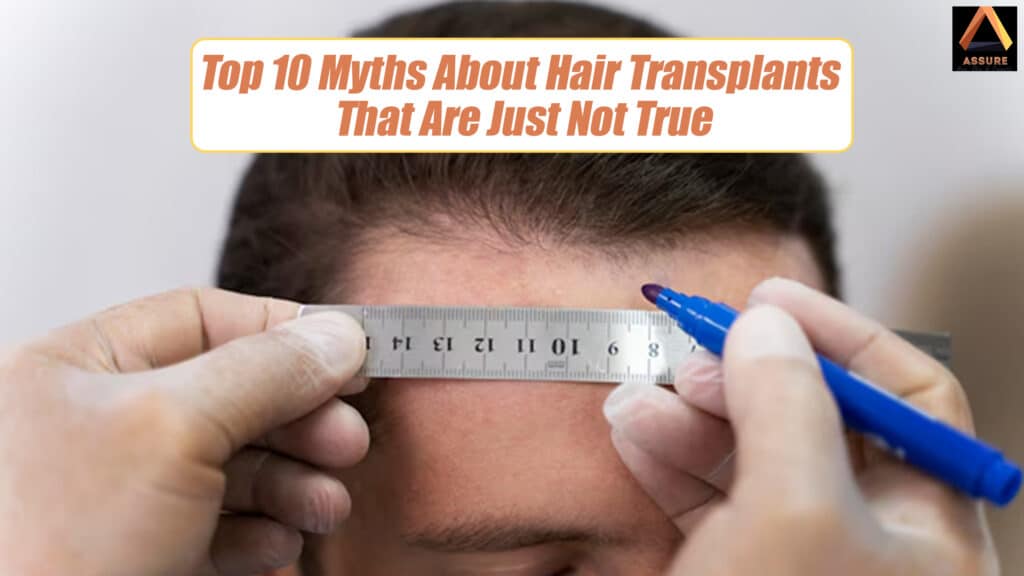Follicle Count:
Follicle Count:

One can find hair loss irritating and even frightening. Many people look for answers but become caught in false hair transplant rumors. These stories cause uncertainty and anxiety, which prevents people from seeking actual treatment.
This article helps to clear those ambigues. It will guide you through the most regarding hair transplant myths,, clarify the real facts, and boost your confidence in making wise decisions. This is for you if you are wondering what truly happens or thinking, “Is hair transplant safe?”
Among the several hair transplant fallacies is this one. Many believe only men can have hair transplants. That is not accurate at all. Men and women find success with hair transplants. Everybody deals with hair loss. Women could develop large part lines, thinning hair, or bald patches. For both sexes, hair transplants can help one regain confidence.
Many people overlook the fact that women also suffer with hair loss as marketing for this usually centres on men. The Truth Surgeons can modify hair transplant techniques to fit scalp requirements and hair pattern of women. Growing in popularity worldwide are female hair transplants.
To be really honest, nobody enjoys suffering. One of the common worries is But among the most false hair transplant rumours is the belief that they are quite painful. Local anaesthetic is used by surgeons throughout the operation. Usually, patients experience either minimal or none at all. Though not intolerable, there may be some minor discomfort.
Many people relate it to the uncomfortable but controlled sensation of dental procedures. Indeed, under the direction of qualified experts, newer techniques like FUE and DHT are usually safe.
Some people picture thick, fake-looking hair plugs when they think about hair transplants. This is one of the old-school hair transplant myths. Hair transplant technology has come a long way. Surgeons now use advanced techniques to create natural-looking results.
According to the International Society of Hair Restoration Surgery (ISHRS), over 90% of patients report that people can’t tell they’ve had a transplant. That’s huge.
Patience is key. One of the most common hair transplant myths is thinking the results are instant. Unfortunately, that’s not how it works.
Knowing this helps you manage expectations. Hair transplants are a long-term solution, not a quick fix.
Some people believe that hair transplants are luxury procedures only celebrities can afford. But this is another outdated hair transplant myth. While hair transplants used to be expensive, prices have dropped thanks to better technology and more skilled surgeons.
In many countries, the cost is similar to buying a used car or taking a short vacation. For many people, this is manageable with payment plans. Global demand for hair transplants has risen by over 60% in the past decade, making the procedure more common and affordable.
Some people are told that hair transplants don’t last. But this is one of those hair transplant myths that really needs to go. Hair is taken from areas resistant to hair loss, usually the back of the scalp. These hairs are genetically programmed to keep growing. Most people keep their transplanted hair for life. However, untreated areas may still thin over time, so follow-ups or medications might be suggested.
Age is just a number when it comes to this treatment. Believing that you can be “too old” is another false hair transplant myth. There’s no strict age limit. Doctors look at your health, scalp condition, and hair quality—not just your birth date. Yes, as long as the patient is healthy, the procedure can be safely performed even in their 60s or 70s.
This is one of the wildest hair transplant myths out there. It’s completely false.
There’s no way for the surgery to touch or harm the brain. It’s like saying getting a tattoo on your arm could hurt your bones—it just doesn’t make sense.
When people ask, “Is hair transplant safe?” this myth can make them nervous. But the truth is that hair transplants are low-risk when performed by trained professionals.
Like any minor surgery, there’s a small chance of swelling, infection, or bleeding. But these are rare and usually easy to treat.
This is one of the most confusing hair transplant myths. No, you can’t just take hair from your friend or family member. The body will reject hair from another person, just like organ transplants need special matching. Hair transplants must use your own hair to succeed. Surgeons always use the patient’s own hair from the donor area. It’s the only way the body will accept and grow it.
Many hair transplant misconceptions have obviously been around for far too long. They frighten people and prevent confident judgements from being taken by them. The truth is, though, hair transplants nowadays are easily available for men and women, safe, natural-looking.
And If you have ever questioned, “Is hair transplant safe?” the response is indeed yes, provided qualified experts do the work. Always seek appropriate advice, ask honest questions, and avoid allowing legends to direct your decisions. To explore safe, trusted hair transplant solutions, visit Assure Clinic.
Welcome to India’s Leading Hair & Skin Clinic
Transforming Lives with Expert Care and Advanced Techniques

Read our latest articles on hair and skin care.
Copyright © Edit Hair and Skin Clinic Pvt Ltd | All Rights Reserved | Privacy Policy | Payment T&C | Shipping Policy | Cancellation Policy |

